A simple guide to Iwata airbrushes
This page is intended as a simple, helpful guide to those who don't know anything about the specifics of an Iwata airbrush. While we don't go into too much detail here, most of a particular airbrush's information can be found on it's individual product page or in the helpful videos we've provided for airbrush tanning and airbrush makeup.
Laid out as more of a quick reference guide with photos, you can easily get the information you need to make an educated decision when shopping for an airbrush or kit. We do not sell all of the airbrushes used in these examples as we have a selected few that are best for our purposes of spray tanning, airbrush makeup and airbrush tattooing. These particular examples are chosen to show the major differences between the available Iwata airbrushes out in the market, not necessarily just what we carry. Of course, if you have more questions, please refer to our online manual for assistance, or we would be happy to help you through our Contact Us page.
Top & Bottom Feed Airbrushes
Top-Feed Example: Iwata Eclipse HP-CS
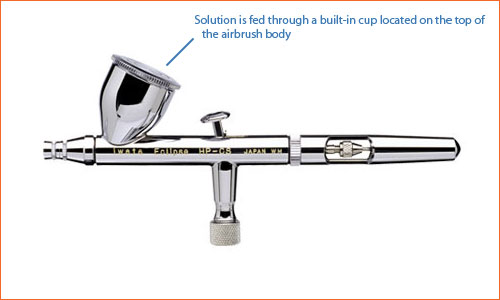
With the airbrush bottle holding between 1oz and 4oz depending on the bottle size, these bottom-feed airbrushes hold much more solution than top-feeds and are perfect for airbrush tanning.
Double Action Example: Iwata Revolution BCR
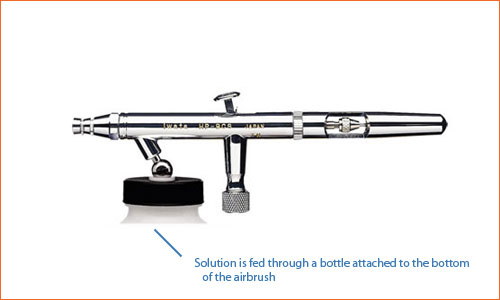
With the airbrush bottle holding between 1oz and 4oz depending on the bottle size, these bottom-feed airbrushes hold much more solution than top-feeds and are perfect for airbrush tanning.
Single Action & Double Action Airbrushes
Single Action Example: Iwata Revolution SAR
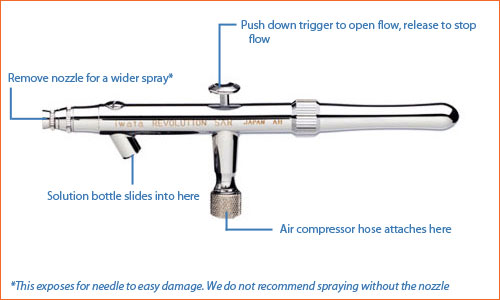
The 'action' of an airbrush refers to the trigger actions of an airbrush. A single action airbrush controls the adjustment of the solution through the trigger whereas the airflow is adjusted through the compressor. We do not carry any single action airbrushes as these airbrushes are typically used for hobby art due to lack of blending and fading control necessary for airbrush tanning and makeup.
Double Action Example: Iwata Revolution BCR
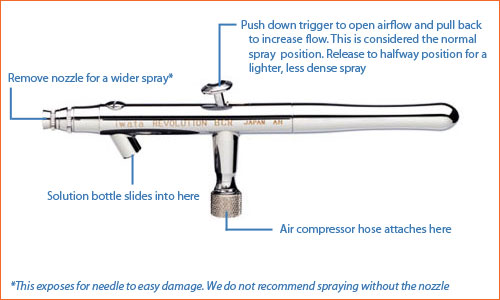
A double action airbrush allows both the control of the solution and airflow through the trigger. The maximum airflow psi (per square inch) should be set and adjusted on the compressor while the solution and airflow to actually come out of the nozzle is controlled by the trigger. In essence, with a double action airbrush, the artist is able to control and adjust the width and darkness of the spray without stopping their hand motion.
Basic Airflow Troubleshooting for Airbrushes
Example: Iwata Revolution BCR - Adjusting the Airbrush Needle
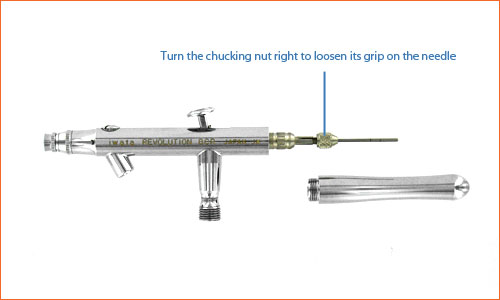
Occasionally, it may be necessary to adjust the position of the airbrush needle if airflow is inadequate for the needed purpose. Loosen the needle chucking nut, then slide the needle slightly backward for more flow or slightly forward for less flow. Take absolute care not to crack or split the nozzle as it is very delicate and must be replaced if broken.
Spray Guns
Example: Iwata G5

With a higher throughput and wider coverage than typical airbrushes, airbrush tanning with a spray gun is no longer uncommon. If used correctly, it can perform with the same grace and consistency while drastically cutting tanning time to almost half. While normally reserved for larger and more demanding jobs, the spray gun is definitely another alternative to airbrushes.

